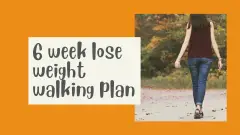How much exercise does it take to burn 100 calories? It depends on what you do, in general the harder you’re working and the more out of breath you feel, the more calories you will be burning. For an average weight woman, walking at an average speed, it will take 24 minutes to burn 100 calories. But you can easily increase calories burned walking by adding in some intervals at a faster speed. Even better, add in some jogging.
The chart below compares how many calories an average weight woman would burn doing variations of walking and running for 24 minutes. The good news is that if you weigh more, you burn more calories!
Calories burned walking

You need to eat healthily too
Walking and running burn calories, but it would take a LOT of exercise to compensate for over-eating or eating the wrong sorts of foods. To maintain a healthy weight, it’s better to combine exercise with a good diet. Read more about healthy eating here.
Other benefits of walking and running
Weight control is only one of the benefits of a walking or running program. Other benefits include:
Good for heart and circulatory system
When we exercise, we increase the demands on our heart and circulatory system to deliver blood to the working muscles. This causes them to adapt by becoming more efficient.
Keeps muscles strong and flexible
In the same way, muscles adapt to exercise by becoming stronger. They’re also likely to become more flexible, even without a specific stretching program. This is because during exercise we usually take our joints through bigger ranges of movement than in everyday life, which keeps our muscles flexible.
Keeps joints mobile
The joints themselves also benefit from regular exercise. Movement keeps the joint capsule lubricated and strengthens the ligaments and tendons supporting the joint.
Maintains bone mineral density
Weight bearing exercise (that is, where you are moving and supporting your weight on your feet, as in walking and running) helps to build and maintain bone density. Low bone density makes the bones more susceptible to fractures and is especially a problem in post menopausal women. It’s important for women to build up as much density as possible pre-menopause and then to keep exercising to maintain it post menopause.
Reduces stress and anxiety and improves mood
Exercise is very beneficial for mental health, especially if it’s outdoors.
Improves sleep quality
This is linked to the effects of reducing stress and anxiety. If you suffer with insomnia, exercising outdoors every day can help you to be calmer and sleep better. Read more about sleeping better here.
Increases energy
While exercise may be tiring in itself, the overall effect is that it increases our energy levels.
Helps to protect against many degenerative diseases
Years of research have shown that maintaining an active lifestyle helps to protect against many illnesses including type 2 diabetes, cancer and dementia.
Helps to offset ageing
While our bodies unfortunately do deteriorate with age, this can be offset to a significant extent by a regular exercise program. Ideally, this should include both cardio and strength exercise.
In summary
- All walking has a range of health benefits and burns calories
- Walking faster or adding in running intervals increases benefits and calorie burning
- You should combine exercise with healthy eating for optimal weight management
Buying a treadmill for home use
Now that folding treadmills are widely available, having a home treadmill doesn’t mean you need a dedicated workout space. You can fold your treadmill up and store it out of the way between workouts. If you’re thinking of buying a home treadmill, here are some points you should consider:
- Are you likely to run on it? If so, you should avoid very lightweight models. Also, a cushioned running/walking deck will help to absorb impact.
- Dimensions: there’s a slight variation in dimensions between models. If you’re tall, you might prefer a longer walking/running deck to allow for a longer stride. Obviously, the treadmill needs to fit in your chosen storage place when it is folded away.
- What sort of a console do you want? Is it important to you to have a multi-feature console with a choice of preset programs, or will you be happy with something simple that just lets you set speed and incline? Extra functions add to the cost of the treadmill, so think about whether you really need them.
- What is the incline range? Some treadmills only have a limited incline range. Models that offer up to 12% give you more options to vary your workouts and to challenge yourself more as your fitness improves.
- Maximum speed – if you run fast, or plan to do sprint intervals, you should bear the maximum speed in mind. For walking, or average speed running, any treadmill will be fine.
See a treadmill buying guide here.
Related to calories burned walking
Try these walking programs to start burning calories:

